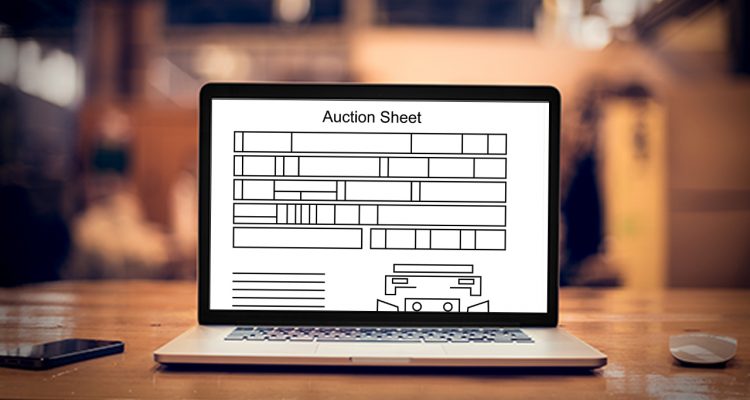In this article, we are going to guide you on how to read auction sheet with grades step by step. The information written on the auction sheets are just numbers and codes which are easy to understand.
Table of Contents
Introduction
When you are buying a used car through an import, one of the most critical documents you’ll encounter is the auction sheet. The auction sheet has all the information about the car’s background, quality, and overall condition, this report helps the buyer to make wise decisions while purchasing any used vehicle. However, understanding the auction sheet and its grades can be a daunting task for those unfamiliar with how to read auction sheet.

In this article, we will guide you through the process of how to read auction sheet, decipher the grades, and make an informed choice when purchasing a used vehicle.
What is an Auction Sheet?
An auction sheet is a detailed document used in the automotive industry to assess and describe the condition of a used vehicle. It is typically prepared by professional inspectors who thoroughly examine the vehicle and assign grades to various aspects. These grades are often numerical or alphabetical, and they provide valuable insights into the vehicle’s condition, history, and any potential issues.
How To Read Auction Sheet?
We have explained briefly below how to read auction sheet but if you need an expert to read the auction sheet for you then feel free to contact us at Autoones or call/Whats App us at +44 7594 766932.

Let’s break down the key elements of how to read auction sheet with grades:
Overall Grade
S – Denotes that the car you are considering is new. The speedometer displays fewer than 10,000 kilometers, and the registration date is frequently shorter.
6 – Identify nearly new vehicles whose registration dates are up to three years old. Mileage ranges from 0 to 30 000 km, usually 0 to 10 000 km. You can come with a few hardly noticeable scuffs on select auction pages.
5 – Denotes a used car in top condition. The speedometer displays up to 50,000 km. On the body, there could be a few little scratches as well as possible tiny dents.
4.5 – A car with continued strong demand. Mileage up to 100,000 km is displayed on the speedometer. There may also be some dents or scrapes, and there’s a chance you’ll find a car with bodywork that has been repaired or replaced.
4 – The car wasn’t involved in the collision. Up to 150,000 km may be displayed on the speedometer. There could be obvious scratches, inside tears, cigarette burns, or stains.
3.5 – Identify an automobile that may have significant dings, dents, rust, or corrosion (rare). Frequently, stains, cigarette burns, and tears can be seen inside the car.
3 – Mark vehicles with obvious large dings, dents, paint blemishes, rust, and corrosion. Tears, cigarette burns, or food stains throughout the interior.
2 – Usually indicates a lot of rust and corrosion, but various breakdowns may be present. Generally speaking, this indicates that the car is in bad shape.
1 – Typically waterlogged cars.
RA – A vehicle that has been repaired following a typical auto accident.
R – Typically, a vehicle from a serious auto accident. This car might be fixed, but it probably needs further work. Be aware that this car might not be moveable.
*** (99, x, etc.) – This car has either been in an accident or has severe engine problems that have not been rectified.
Exterior Condition (Grade 3-5, A-C):
Grade 5/A: Excellent condition with minimal to no visible damage.
Grade 4/B: Good condition with minor scratches or dents.
Grade 3/C: Average condition with noticeable signs of wear and tear.
Interior Condition (Grade 3-5, A-C):
Grade 5/A: Interior is in excellent shape with no significant flaws.
Grade 4/B: Interior is in good condition with minor wear.
Grade 3/C: Interior shows signs of heavy use or damage.
Mechanical Condition (Grade 3-5, A-C):
Grade 5/A: Mechanically sound with no issues.
Grade 4/B: Some minor mechanical issues that may require attention.
Grade 3/C: Significant mechanical problems requiring immediate repair.
Mileage:
Lower mileage is usually preferred as it indicates less wear and tear on the vehicle.
Service History:
Check if the auction sheet mentions regular maintenance and service records.
Accident History:
Look for any information regarding past accidents or repairs.
Additional Notes:
Inspectors often provide additional comments or details about the vehicle’s condition and any specific issues.
Abbreviations used on the Auction Sheet:
Air conditioner with climate control=AAC
air conditioning=AC
The word “airbag”=AIRBAGU
Original Alloy Wheels (AW)
Column Automatic Transmission=CA
F5 – Manual Transmission with Five Speeds & F6 – Manual Transmission with Six Speeds
Leather seats, KAWA
Navigation=NAVI
Now that you know how to read auction sheet grades,it will help you make an informed decision.
You might like: How to verify Japanese Car









